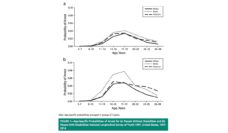Discrimination comes in many forms, targeting people based on their race, age, sex, sexuality, and weight, among other attributes. Few studies have examined the effects of accumulated experiences of discrimination over time and across types, which researchers argue present a more complex explanation of poor health.
Authors Laia Bécares and Nan Zhang analyzed the effects of cumulative perceived discrimination on 1,613 Black, Chinese-American, Japanese-American, and non-Hispanic White older women’s mental health in the United States. Perceived discrimination was measured by a modified version of the Everyday Discrimination Scale, which asks respondents to rate how often they face specific discriminatory situations daily.
Items on the researchers’ scale included statements like, “You are treated with less courtesy than other people,” and “People ignore you or act as if you are not there,” and “You receive poorer service than other people at restaurants or stores”; each item was counted as a domain. To assess mental health effects, the researchers used the depression symptoms of participants in the study, measured with the Center for Epidemiologic Studies Depression Scale.
The authors found that women who perceive they are being discriminated against based on their race have poorer mental health outcomes than women who do not perceive discrimination.
The authors found that women who perceive they are being discriminated against based on their race have poorer mental health outcomes than women who do not perceive discrimination. They grouped their findings into four classes, based on levels of accumulation of interpersonal discrimination. About a fifth of the participants made up class 1, and reported the most perceived discrimination of all the women studied. Compared to the other classes, this group consisted of the greatest proportion of Black and Chinese-American participants. Class 1 also scored the highest on the depression scale both at the beginning and during the study.
The largest group was class 3, which included one-third of the participants. This made up the group also that reported experiencing many types of discrimination accumulating over time, attributing such experiences to their sex. The members of class 3 had the second highest risk of depression.
The authors suggest that the severity and accumulation of the perceived discrimination against women differs by racial and ethnic identity. About a fifth of the participants scored the highest on the depression scale both at the beginning and during the study. This group also reported the most perceived discrimination of all the women studied. The researchers concluded that the effects of perceived discrimination were found to be more harmful to the mental health of racial and ethnic minority women than to that of White women.
Feature image: Backbone Campaign, Pink Hat Girl with We the People Women’s March DC, used under CC BY 2.0













